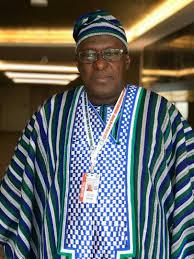Political Marketing: An Election Victory Strategy Pt.2
In part one of this article I introduce the concept of marketing generally and narrow my definitions of the concept down to proposing a context that espouses the ingenuity of commercial and political marketing as well as explaining the similarities that consumers must understand to be able to inform their choice of brand – be they products or political parties. In particular these forms of marketing use three main elements: sellers, products, and buyers, which were also briefly explained. In this second part of my article, I continue with the functions of marketing, especially as they relate to political marketing. (Photo: Mohamed Sheriff Bah, author)
Market Segmentation and Product Mix: Market segmentation is a very important marketing function. Both commercial and political marketing involves market and audience segmentation in a bid to understand which products, services, messages or communications is appropriate to a specific markets or target groups.
For instance, business segment their markets or customers into mass, youths, high value and so on. This is very typical of the Telcos. It was also done in the just concluded elections. Both APC and SLPP established youths campaign coordinators, regional campaign coordinators and even constituency and ward coordinating teams. Media or communication channels are chosen and messages are being developed to suite the different audiences. Segmentation is key to effective messaging. Effective messaging and communication help increase customer base as well as they do with votes.
Market segmentation is actually the process by which consumers and potential consumers of products, services or ideas are distinguished and categorized based on certain variables. This is done in order to create homogeneous groups, and select some of them as targets for a satisfactory product and communication mix intended to achieve a company’s goals such as profit maximization, growth, market share and support base. The same applies in political marketing but with the ultimate goal of maximizing votes and ramp up goodwill. This comparative analysis shows that both commercial and political marketing use identical segmentation variables such as age, sex, income, occupation, family size, race, personality traits, life style, constituency and region.
Product Image: Both product and candidate marketing have emphasized on consumer and voter behavior toward products and candidates, with branding undoubtedly being a very important marketing function. Africell market so that their products appear affordable, youthful or mass. This has, over the years, helped them increase their subscriber base, especially among the youths segment. Orange on the other hand is perceived to be an affluent network, hence the reason they are dubbed “the Bomba network”. This has also helped them earn a bigger market share from the affluent segment which they refer to as high value customers. I’ll elaborate in my subsequent writings on market/customer segmentation from a commercial marketing viewpoint. Interestingly, a lot of improvement is needed on this in the country’s political marketing activities. Over the years, many will agree with me that voters refer to SLPP as being “too elitist” and APC as “the party for the grassroots”. This calls for both parties to work on their overall brand images.
Invariably, commercial and political marketers strive to build their brand elements through various means. Without a proper brand image to identify a particular business or candidate with, it will be difficult for other marketing activities to be successful.
We saw how brand image was interpreted in the just concluded March general elections in Sierra Leone where voters associated hardship and economic crises with the then All People’s Congress (APC), the party in government between 2007 and 2018. I would say that it is against such backgrounds that brand image has sometimes come to be understood as an impression or a stereotype that consumers and voters have about products and candidates. A recent study suggests that image is a result of an interactive perceptual process through which the perceiver selects some of the object’s attributes – brand and quality of a product, party affiliation and issues of a candidate – processes them in their minds and forms predispositions to respond toward the object.
Brand Loyalty: Brand loyalty is another brand element that is very critical in long-term relationships. When measured by the degree of attachment to the brand (as indicated by repeated purchase or brand attitude), and related to such consumer’s characteristics as age, income, race, personality, brand loyalty becomes equivalent to the concept of party loyalty in political marketing. Often, the concepts of brand and party loyalty have been utilized as a baseline for promotion strategy for the product and the candidate. Generally, the first step of such promotion strategy is to distinguish between loyal voters and swing voters and hence design a different promotion mix for each of the two main groups (Campbell, et al., 1966). In addition to the commonalties discussed above, both commercial and political marketing also utilize common marketing tools such as communication channels, market research and marketing mix.
Market Research: Both commercial and political marketing professionals make frequent use of market research or public opinion polls for the purposes of measuring product or candidate’s performance, identify potential consumers and trends and detect and solve problems. In doing so, market and opinion research use similar methods of data collection (focused groups, interviews, questionnaires) and data analyzing techniques (regressions, factor analysis, discriminant analysis, multidimensional scaling).
Communication Channels: The use of communication channels for the purpose of promoting economic products and political candidates is another characteristic of both commercial and political marketing. Both commercial and political marketing use, inter alia, radio, TV, outdoor channels, social media, and website as communication channels to disseminate messages and engage with customers or voters. Social media, for instance, was effectively used in the recent elections. Another typical scenario is Radio Democracy FM 98.1. The station is used by both economic and political marketers. We see even when the station hosts politicians it takes breaks to play radio commercials that effectively promote businesses. By the way I like the Sierra Leone Commercial Bank and Union Trust Bank commercials they air on their “Good Morning Salone” show.
Both political and commercial marketing use media schedules and media mix to effectively reach target groups. Probably the primary and most important difference between the two is that political marketing is used to raise awareness and inform members of the public about critical issues and leadership choices within their community, state, and country.
In the Sierra Leone context, Henneberg’s definition provides more clarity to political marketing theory as it seeks to emphasize the importance of long-term political relationships as a profit for society, mutual exchange and fulfillment of promises. The people of Sierra Leone voted a new government based on the party’s ability to convince voters to believe in promises contained in their ‘New Direction’ manifesto document. Similar to what is referred to as product trial in commercial marketing the people were once again trying a product, the SLPP. Political marketing can bring politics closer to citizens by making party programs more relevant, explaining governance and political concepts more clearly in line with public attitudes and most importantly it can make politics more appealing.
Branding in Politics
Loosely defined, political branding is about what the public think of a political party or a politician. Political branding is the perception, association, feeling, image and interpretation of a particular party or a politician by the public, nation or the electorate. Lately, politicians and political communication professionals frequently rely on brand insights and brand professionals to improve on their external presentations. Political branding, as part of the overall political marketing activities, seems to be in vogue and is effectively being pursued as a deliberate strategy by political actors in modern day political activities.
When effectively utilized, political branding helps a party or a candidate change, improve or maintain reputation and support. It also could create a feeling of identity with the party or its candidates and create a trust in relationship between political elites and voters. It helps political consumers understand more quickly what a party or a candidate is about and are able, as a result, to distinguish a candidate or party from other competitors. There are many indicators that political brands are of considerable significance for voting decisions. In Sierra Leone, for instance, we see how the SLPP and APC have been the parties in charge since independence in 1961. This is because these two parties have strong brand presence than any other parties so far.
It is reported that over the last two decades or so, politicians and parties in various countries have often relied on insights and even brand experts to promote and enhance their brand images. Scammell (2007), White and de Chernatony (2002) have all observed that the rebranding of UK’s working-class Labour Party into third-way ‘New Labour’ sometime in the 1990s was aided by professional branding firms. Successes from that rebranding activity motivated former Prime Minister Gordon Brown to hire a brand expert in the person of David Muir, author of the book The Business of Brands (2004), as director of strategy (The Guardian, 2008; The Telegraph, 2008).
The Conservative Party established similar position, the head of brand communications, a job title that was found in the corporate world by the time (The Guardian, Sweney 2006). Brand thinking has reached politics in several countries today. For instance, Schneider (2004) reports on a series of interviews with leading German politicians, in which they used the terms ‘brand’ or ‘branding’ several times during politicking to refer to their communication activities.
How to stay in power or win elections from a marketing point of view?
For a political party to be always successful, it must maintain its brand identity at all time – before, during and after elections. This means continuous marketing brand building — brand image, brand loyalty, brand awareness and, most importantly, brand love. People tend to be more loyal to brands they love. Brand recall is key, as it were, to winning an election, especially. This may be attained only through continuous brand-building efforts. However, I believe this could still be taken beyond its current laurels. In essence, political campaigns should come as a brand enhancer instead of a brand building strategy. Every political party must have a political marketing professional that is capable to design and implement winning marketing strategies.
As I conclude this peroration of a piece, I’ll recommend six strategies that political parties especially in Sierra Leone must use regularly and effectively to build, maintain and improve their popularity. It particularly works better for a party in governance and in which case if effectively harnessed by the SLPP, for example, they stand a chance to be very successful in government.
- Define your goals: Clearly outline quarterly or annually what your party aims to achieve. Do not wait for elections time. However, these goals must be in line with your overall long-term goals;
- Collect relevant data: Gather and organize any statistics or information relevant to your goal;
- Interpret the data: Analyze trends and any deviations from those trends to see how this has affected meeting your goals;
- Develop recommendations: Provide justified suggestions on how to improve party practices based on what you have learned from your data analysis;
- Take action: Put your recommendations into practice and create an action plan to test your assumptions;
- Review your outcomes: Evaluate whether your actions have had the desired impact and make notes of how you can further optimize to improve results.
By Mohamed Sheriff Bah, MA Marketing
Stay with Sierra Express Media, for your trusted place in news!
About the Author: Mohamed Sheriff Bah is a Mandela Washington Fellow, a certified Digital and Social Media Marketing professional and an Entrepreneur. He holds an MBA in marketing from Marmara University, Istanbul, Turkey and a B.A honours in Mass Communication from Fourah Bay College.
Follow Mohamed on his blog: https://mohamedsheriff.blogspot.com/
Find him on Limey: Mohamed Sheriff Bah, Facebook: sulaimandara
© 2018, https:. All rights reserved.






